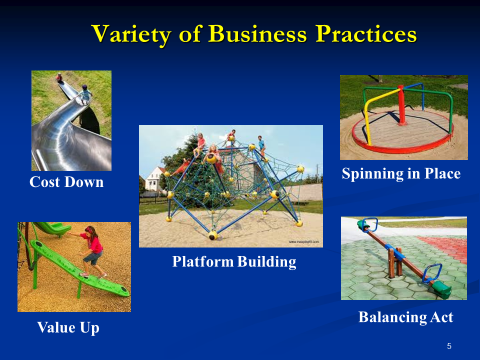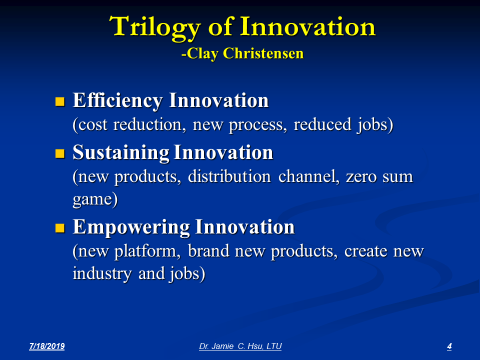
Cost Down or Value Up?
– Musings of Dr. Jamie Hsu, 7.25.2019
This is a brutally competitive era for business. Globalization, fast information flow, low freight costs, uneven labor costs, and demanding customers have made business survival a very challenging act.
Under such competitive pressure, the most obvious move for a business is to drive down the cost, but how low can the cost go? Eventually this unrelenting squeeze on cost will eat into profit margins and quality standards. This causes the so-called “Red Sea Competition” where dead businesses are everywhere.
As a result, the more sophisticated and innovative companies begin to create new value for customers through design, quality, product features, and service. But these value-up “Blue Ocean” advantages may be short-lived as the competition begins to mimic the good ideas. These new ideas and intellectual properties must be protected by strong patents and trade secrets to maintain a sustainable competitive advantage.
Clayton Christensen, a Harvard Business School professor, proposed three types of innovation for a company:
– Efficiency Innovation focuses on productivity in operations and cost containment in labor, capital, and supplies. Walmart is very good at this.
– Sustaining Innovation develops new products, features, and services to retain customers and market shares. The auto industry has been doing this for decades.
– Empowering Innovation creates better designs, novel ways of doing business, and new services that address unmet customer needs. It creates a platform for customers, and other companies to develop products and applications, eventually creating a new industry. This innovation can give a company the dominating position in an industry for a long period of time. The smartphone is a great example.
As a company goes through various business cycles and competitive threats, it is essential for the leaders to go beyond the choice of cost down or value up, and to employ all the proper innovation tools. Only by having the trilogy of innovation can a business have both short-term and long-term success.


價格與價值的競爭
-作者 許俊宸博士
-中譯 薛乃綺
要說做生意,我們處在一個殘酷的世代!全球化、快速的資訊流、低運費、不對等的勞動成本以及難搞的客戶,已經讓企業是否能生存變成一項艱鉅的任務。
在如此的競爭壓力下,企業最明顯的作為就是降低成本,可是究竟能降到多少?這樣持續不斷地壓縮成本最終將影響到企業的利潤以及品質標準。也就是無所不在的”紅海競爭”, 造成了许多‘惨業‘。
因此,更尖端、更創新的企業開始透過設計、品質、產品功能及服務,來為客戶創造新價值。 可是,這些‘藍海競爭‘的優勢,也可能因为其他競爭者的模仿,變得是短暫的優勢。這些新想法和智慧財產權必須受到強大的專利與商業祕密的保護,才能獲得永續的競爭優勢。
哈佛大學的創新大師Clay Christensen提出企業的三種創新:
- 效率型創新(Efficiency Innovation)著重在營運生產力以及勞動力、資本、供應商的成本控制。沃瑪就相當擅長於此。
- 維持型創新(Sustaining Innovation)則是開發新產品、新功能、新服務,以此留住客戶與市占率。車輛產業數十年來都是這麼做。
- 授能創新(Empowering Innovation)*是創造更好的設計、更新穎的經營方式、以更新的服務滿足尚未被滿足的客戶。它為客戶及其他公司創造了一個平台,用來開發產品及相關應用,最終將創造出一個產業。這種創新將使企業經歷一段長時間之後,變成居該行業中的領導地位。智能手機就是很好的例子。
當企業經歷各種經濟週期與競爭威脅時,領導者必須要有降低成本或增加價值之外的選擇,並且要採用適當的創新工具。只有了解創新三部曲,企業才能同時獲得短期和長期的成功。
* “授能創新”係引用自天下雜誌533期(2013-10-16),<你的企業需要哪一種創新?>內文中,對於Empower innovation的翻譯.


